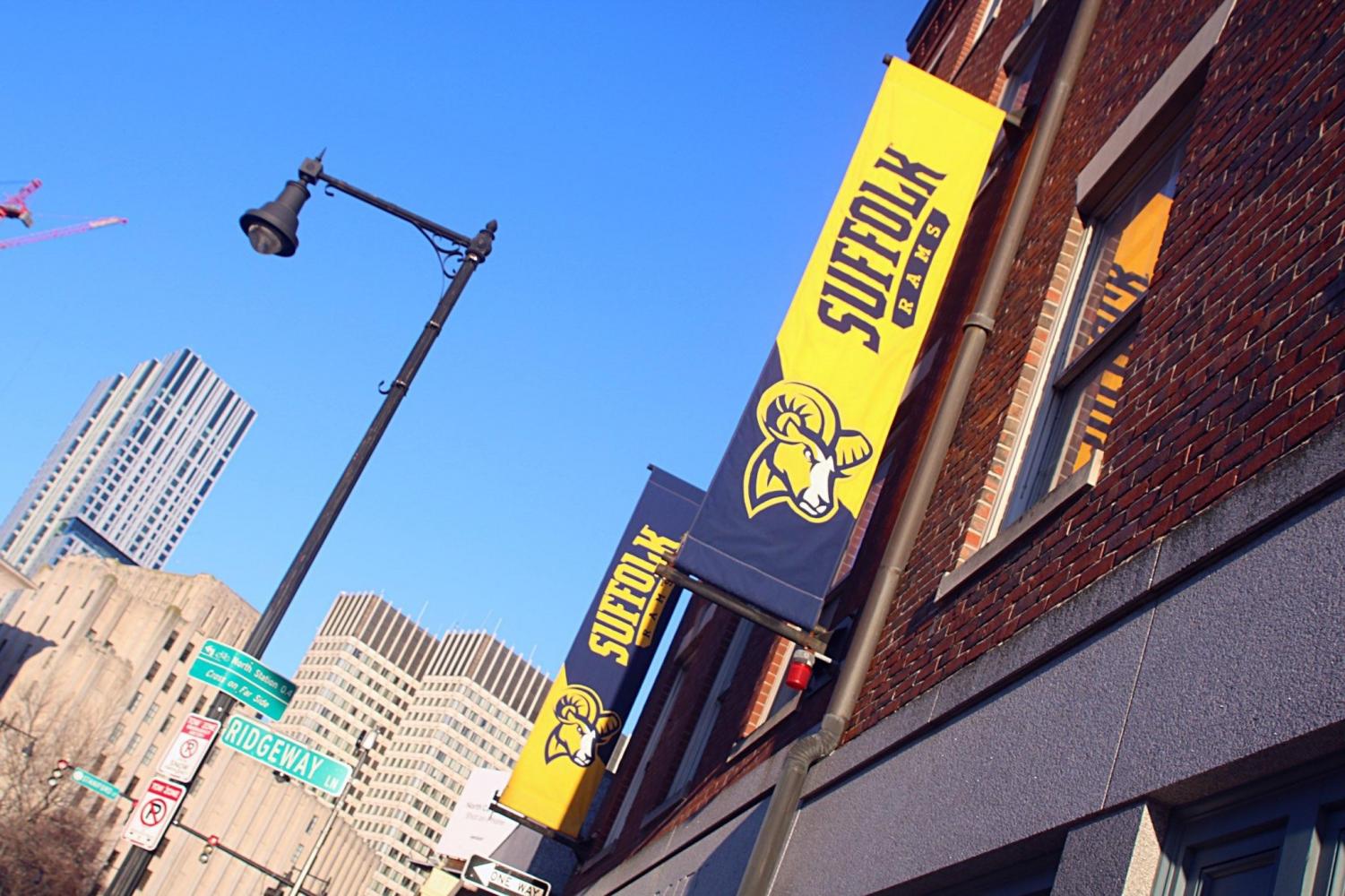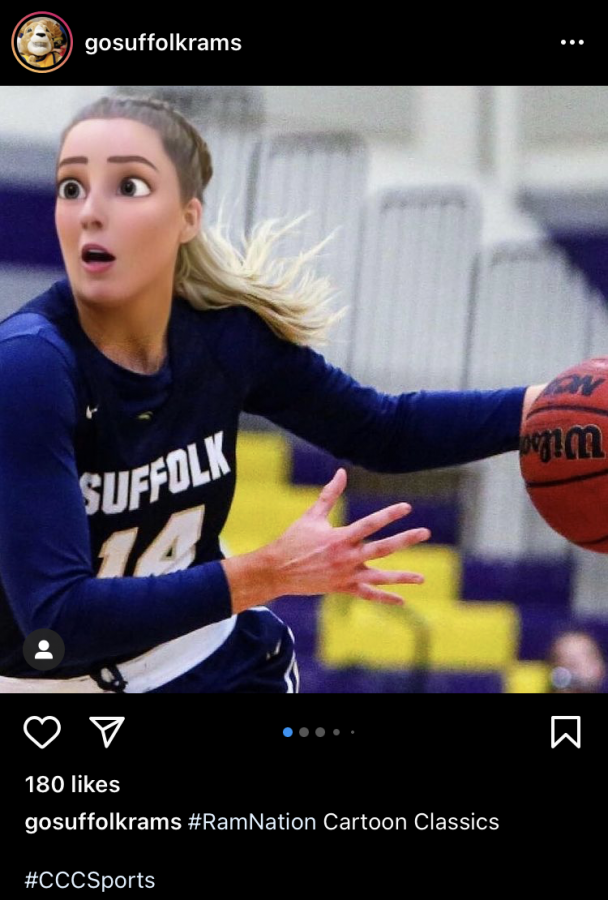As Suffolk Athletics lags university on diversity, ex-players of color say they faced discrimination
Suffolk Magnified is a section of The Journal that takes a closer look at serious issues within the Suffolk Community. If you have a story to share, email [email protected].
April 20, 2021
Despite Suffolk University having a considerably diverse student population, most student-athletes at the school are white. And when discrimination complaints in Suffolk Athletics do arise, current and former students said the department has ignored them.
Former player says she faced discrimination on women’s basketball team
Samari Winklaar played on the women’s basketball team at Suffolk during the 2018-2019 season.
Winklaar, who graduated from Suffolk last year, was a recent transfer student when she was recruited to play for the team by Head Coach Ed Leyden that season.
“The coach was very convincing that he would play me, and [my family and I] thought the program looked amazing,” Winklaar said.
Winklaar had played Division II basketball at Franklin Pierce University for two years before coming to Suffolk’s Division III program.
She said Leyden told her, “We don’t have a lot of people like you on the team” when he was recruiting her. While Winklaar thought he meant a D2 player at first, she later felt like he was actually referring to the color of her skin.
“I’m kind of light skin. I’m not even that dark. But my hair tells it all… I’m Hispanic. I’m Latina. I am Dominican and come from Caribbean descent. I have a little bit of mix in me,” Winklaar said. “But right away, it was really difficult. Right away, there were racist comments on the team.”
One of these comments came from Leyden at a practice before a game, Winklaar said. When the team was gathered together, Leyden used her as a reference to girls who were Black on the other team.
This comment, Winklaar said, was “There are two girls on this team. One comes in after the other, and they both look like Samari.”
One of Winklaar’s former teammates, who wanted to remain unnamed, told The Journal that Leyden never said this and that he “treats every single player on his team equally, with dignity and respect.” However, three other players said Leyden made this comment.
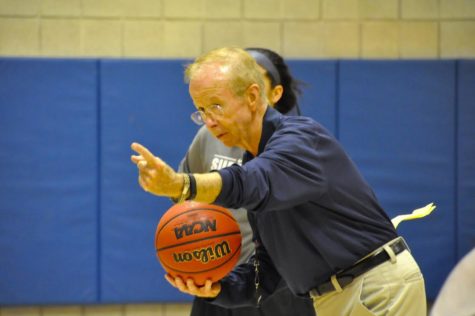
“There have been instances where coach Leyden has used discriminatory phrases that have affected the girls of color that were on the team when I was present,” said one of these former players, who also wished to be anonymous. “I felt it was not fair nor appropriate to single out the girls of color just to compare them to other girls of color on opposing teams.”
Winklaar said she also witnessed racist comments made by her fellow teammates. She said one of her captains called an opposing team that was mostly made up of Black players “a bunch of hood rats.”
“I felt like an outsider looking in, and I was on the team,” Winklaar said. “I didn’t feel comfortable around my teammates.”
The discrimination she faced while on the team went beyond comments though, she said.
While Winklaar played in 15 of the 27 games that season, she saw only about 5 minutes of playing time in those games on average, according to her player profile on Suffolk Athletics’ official website.
“There was one game I played and I scored in like three minutes, and I [kept getting rebounds],” she said. “That was the only time I really played, and I scored.”
Winklaar said she always worked hard in practice and came in shape for the season. While Leyden would offer specific advice to other girls on the team about how they could improve, she said he only ever told her to “work on the little things” and wouldn’t get more specific than that.
One student of color who played on the men’s basketball team that season said he was surprised that Leyden hardly played Winklaar.
“I would give [Samari] the benefit of the doubt because I would see that she would be in the weight room when no one else was in the weight room,” said the student, who wished to remain anonymous. “She would play well in practice whenever I watched the girls practice before our own.”
A discrimination complaint that felt unheard
Winklaar was cut from the team over text by Leyden after tryouts for the 2019-2020 season.
“[Samari] was a very good player,” said Arlly Villanueva, who tried out for the team that season. “She was absolutely the quickest one on the whole team. She beat everyone every single time and it just threw me off when she said she got cut too.”
Villanueva, who is Dominican, tried out as a walk-on. She said she had a good experience with the players at training sessions over the summer and at tryouts, and assumed she ultimately didn’t make the team because there were better players.
That changed once she heard Winklaar had been cut and the only other player of color had left.
“Then I was like, wait, no one’s left, it’s all just white people? That was a weird red flag for me,” Villanueva said.
Winklaar said her time on the team took a toll on her, and that getting cut was almost “a relief.”
“Being on the team was so stressful because I felt like I didn’t fit in,” Winklaar said.
Around the time she got cut, and after her friends and family encouraged her to report what had happened, Winklaar went to Associate Dean of Students Shawn Newton with a document detailing her experiences on the team.
“I didn’t know who to go to, and I didn’t know who to talk to. I would just talk to my family,” Winklaar said.
Newton told Winklaar that he couldn’t do anything about the case because it was an athletics issue but reached out to Suffolk Athletic Director Cary McConnell on her behalf, Winklaar said.
Newton, who leads Suffolk’s bias response team, told The Journal he cannot comment on specific student cases. He added that students should report bias, discrimination and hate incidents through the university’s online reporting form.
“Anytime someone reports a bias incident or hate crime it is immediately investigated and followed up on promptly,” Newton said.
Winklaar said she had a meeting with McConnell and two other coaches in the department about her experiences.
“Both the Athletics Department and the University take concerns about diversity extremely seriously,” McConnell told The Journal over email. “While we cannot comment on any individual student’s situation, complaint or concerns, we do review and investigate discrimination complaints and/or grievances according to the University’s bias incidents policy.”
After she shared what had happened, the coaches told Winklaar they would bring the issue to Leyden’s attention but that it was too late to do anything because she didn’t speak up about the problems as they were happening, she said.
Winklaar was also told to focus on her studies and not worry about basketball, she said.
“They just stared at me as I cried,” Winklaar said.
A nearly all white team in a mostly white athletics program
The Journal’s review of online rosters from the 2008-2009 season to present showed that only about 1-2% of players on the Suffolk women’s basketball team in this period were people of color, compared to an estimated 12-52% on the five other D3 women’s basketball teams in Boston during this time.
Leyden has coached the women’s program at Suffolk for 27 years and was head coach during these seasons.
Winklaar said she once pointed out to Leyden that she was the only person of color on the team, and that he “was very defensive right away.”
“He told me, ‘What does that have to do with anything?’” Winklaar said.
Leyden did not respond to multiple phone calls and email requests for comment.
The Journal could identify only one other player of color besides Winklaar who was on the women’s team since the 2008-2009 season. This player, who requested to remain anonymous, said she and Winklaar were benched the most during their season together.
The former player also said she and Winklaar never felt like they fit in on the team.
“I wouldn’t like to believe that it was discrimination because growing up in a diverse community, I almost never experienced it,” she said. “But, I believe because we were the minorities, we were looked down on by the girls.”
She also said that once the season started, Leyden “was not the same welcoming, nice person” that he was over text and phone calls while recruiting her.
The player left the team before the season ended, she said, because she was stressed out by schoolwork and didn’t feel welcomed on the team.
“The coach made it sound like he needed me on the team before I came and when I got there, I was benched,” she said.
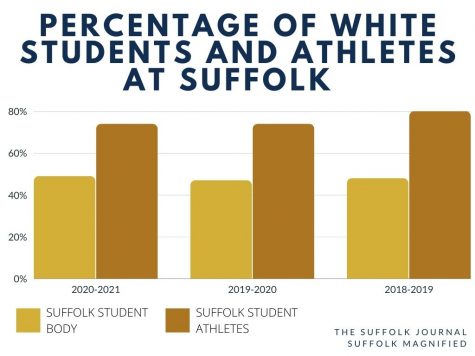
About 80% of student-athletes at Suffolk were white during the 2018-2019 academic year, while white students made up 48% of the undergraduate student body, according to data shared by the university.
Those numbers have shifted slightly, as currently 74% of student-athletes and 49% of undergraduate students at Suffolk are white.
The player from the men’s team said the lack of diversity in athletics was noticeable at nearly every game he played in or worked at, as he was also a work study for the athletics department. He said most of Suffolk’s teams were often less diverse than their opponents, or that sometimes he was the only person of color at a game or in the weight room.
“But the problem I don’t think lies with my teammates,” he said. “The people who brought us together just don’t recruit people who look like me.”
The student, who graduated last year, was the only player of color on the men’s basketball team who saw consistent playing time during his three years on it, he said.
The student said he never felt like he faced discrimination directly during his time as a student-athlete.
“Athletics is the only part [of Suffolk] that’s not really diverse, but it’s not a toxic environment,” he said.
An Instagram post starts diversity controversy
Suffolk senior Fehr AlMehdar was scrolling through Instagram on Dec. 9 when a post from Suffolk Athletics’ official Instagram page caught his attention.
The post featured 10 pictures of Suffolk student-athletes whose faces had been cartoonized through a digital filter.
Every student featured on the post, he noticed, was white.
AlMehdar knew some filters used to create cartoons work only on white faces, something that happens when the technology behind these filters are mostly shown images of white people while learning to view faces. As a result, they can fail to recognize darker-skinned faces. He wondered if this was the case.
“At the same time, I wanted to hint that ‘hey guys, you understand you just used software that only works on white people pretty much? Or that it seems like that at least,’” AlMehdar said.
He commented on the post, “Y’all know you have non-white student-athletes too, right?”
Within a few hours, 11 people had liked the comment.
The next morning, a friend texted AlMehdar that his comment and one from another student who shared similar concerns had been deleted from the post. After commenting again to ask why his first one had been removed, all commenting on the post was disabled.
AlMehdar then privately messaged the Suffolk Athletics Instagram page, which is run by Sports Information Director Amy Barry, to ask why his comments had been deleted. He never received a response.
“Why would you hide that rather than just explain? That was weirder to me than whatever I saw,” he said. “Why are you going to cartoonize people, like make this fun and engaging community on your social media, but not include minority groups? It just seemed off.”
AlMehdar scrolled through the Suffolk Athletics Instagram page to see if people of color had been represented in other posts. What he found, and The Journal saw in its own review of the page at the time, was that the posts overwhelmingly showed only white students.
The post was removed from the page in early April after The Journal asked Barry and other Athletics officials for comment. Barry deferred any questions about the incident to university spokesman Greg Gatlin.
“We can’t comment on specific grievances out of concerns for the privacy rights of both students and employees,” Gatlin replied to The Journal. “Because of the precedent that any comment would set, it’s important we don’t comment on grievances or complaints, as we want to respect the privacy of both students and employees.”
Gatlin said he did not expect Barry to respond to The Journal’s request for that reason.
“I believe inclusivity is the main thing, making sure no one gets left out,” AlMehdar said. “But in athletics [at Suffolk], that culture just doesn’t exist, it seems like.”
Nationally, Division III schools face a diversity crisis
Suffolk Athletics is not alone in its challenges around diversity.
Division III schools across the nation often have mostly white programs, despite their coaches recruiting the majority of their players. According to 2018-2019 data from the NCAA, 74% of D3 student-athletes were white, versus 26% who were not.
Dr. Richard Lapchick, director of The Institute for Diversity and Ethics in Sport, said D3 institutions struggle with having diverse rosters more so than D1 or D2 schools.
“To put it into perspective – excluding [historically Black colleges and universities] – 23.6% of all student-athletes in Division III institutions are of color while 38% of all student-athletes across Division I institutions are of color. That’s an alarming disparity of over 14%,” said Lapchick.
These issues are not exclusive to the student-athlete level of sports. A lack of racial and ethnic diversity is commonplace in coaching staffs, athletic directors and leadership positions. Data from the NCAA showed about 91% of head coaches in D3 were white in 2019, and 92% of athletic directors were also white that year.
“Simply put, it’s difficult to build diverse teams when there’s no diversity at the top,” said Lapchick.
This trend plays out in the Commonwealth Coast Conference, the conference Suffolk currently competes in. From 2012-2020, every athletics director was white, while 94.6% of head coaches and 89.6% of sports information directors were white.
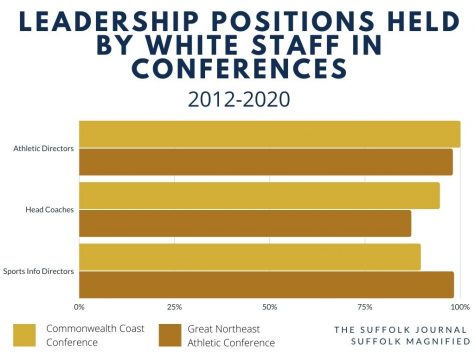
In the Great Northeast Athletic Conference, which Suffolk left last year, 98% of athletic directors were white, 87.1% of head coaches were white and 98.3% of sports information directors were white from 2012-2020, according to NCAA data.
Part of the explanation for these trends come from systemic racism and the lack of equity it has caused in K-12 schools, Lapchick said. Historically, fewer educational and extracurricular resources exist in schools that mainly teach students of color than at schools where most students are white.
“Even in 2021, we see certain school districts in areas that are predominantly Black that continue to be underfunded and missing the technology available in fully resourced school districts,” said Lapchick.
Division III institutions also are not allowed to offer athletic scholarships. With communities of color historically facing financial hardships due to systemic racism, there is often less of an incentive to participate in sports at the D3 level if students have the option to play at D1 or D2, Lapchick said.
These are only some of the barriers students of color face.
“As a Latina, as an African American, you have to work twice as hard anywhere you go to get respect, but I worked my butt off,” Winklaar said. “Even if [Leyden] didn’t think I worked twice as hard, it’s not fair because the system is not fair.”
Some issues are specific to Suffolk Athletics, students say
Winklaar said she faced discrimination as a student-athlete only at Suffolk.
“The problem isn’t Suffolk. It’s the athletic department,” Winklaar said. “Suffolk is listening. The deans are listening. But when they bring it to the athletic department, there’s nothing being done.”
McConnell said the department is working on fostering more diversity and takes student concerns seriously.
“The Athletics Department believes our diversity should reflect that of the larger student body and the University’s commitment to diversity, access and inclusion,” McConnell said. “We realize current diversity levels throughout our rosters and staff are not where we would like them to be.”
Coaches at Suffolk “work diligently to recruit student-athletes from underrepresented minority backgrounds,” McConnell said. The department is looking at adjusting recruiting strategies and hiring more people of color as staff openings become available, he said.
Athletics employees undergo trainings around implicit bias, diversity, inclusion, inclusive leadership, microaggressions and other areas, McConnell said. He plans to have all coaching staff and administrators in the department take part in a six-month educational program starting in May that focuses on diversity and inclusion in sports, he said.
McConnell said he will apply for an NCAA grant next year that provides financial assistance to D3 programs to help them hire more people from historically marginalized communities to athletic administrative positions.
In an email to The Journal, Suffolk Vice President of Diversity Access and Inclusion Joyya Smith wrote that she has “not been directly involved with Athletics” outside of the diversity training done for all university employees.
Suffolk University President Marisa Kelly said diversity and inclusion at the university is important to both her and the Suffolk community.
“What I believe is that across all units of the university, we have a commitment to these issues and that across all units of the university, we have work to do,” Kelly said. “It wouldn’t surprise me if there’s work to do in athletics, just like I think there’s work to do across the board.”
This work must bring about change for student-athletes of color specifically, Winklaar said.
“There’s always going to be an excuse [for why things can’t be fixed], and I don’t know what needs to change in Athletics,” Winklaar said.
AlMehdar said recruiting more students of color to play at Suffolk is one place to start.
“[Recruiting] is the way you get most of your minority students, and if your ways are just getting white people to join, then maybe there is something within the formula that’s messed up,” said AlMehdar.
“I don’t think it’s just any one person out there making sure that no minority students get in,” he continued. “I think it’s just something hidden within the system. [Students of color] are just completely overlooked.”
Follow Caroline and Katelyn on Twitter @CarolineEnos and @katelyn_norwood.

